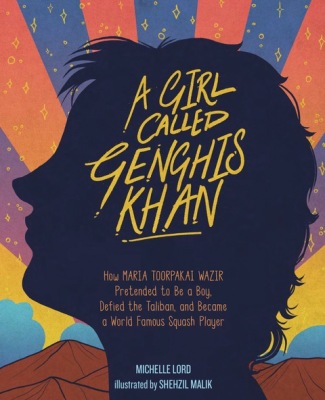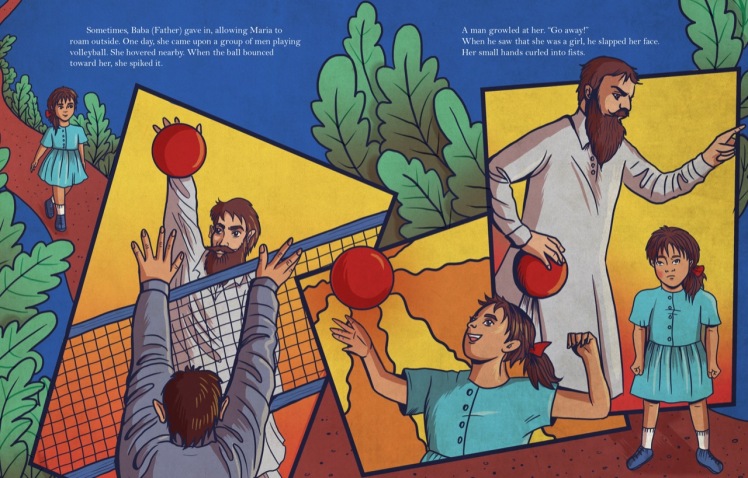It’s so exciting to see a critique partner’s books come out—manuscripts you’ve watched develop from the early stages, take shape, and find their polished form. Michelle Lord and I must have both started investigating Maria Toorpakai Wazir about the same time, unbeknownst to each other. I set it aside, but Michelle kept on it. I think it comes down to what she talks about in this article—the way an author connects to a topic. Thank you for sharing your thoughts, Michelle! And thanks, too, to illustrator Shehzil Malik for joining in!
“Write What You Know?” by Michelle Lord
 Writers have been told, “write what you know.” Did this mean I could only write about people I knew or my own experiences? I was a kid who grew up in a small town in Northern Nevada. A girl who caught tadpoles, made mud pies, and never learned to swim beyond dogpaddling. A teen who spent a year in Brazil as an exchange student. My writing world seemed quite limited…
Writers have been told, “write what you know.” Did this mean I could only write about people I knew or my own experiences? I was a kid who grew up in a small town in Northern Nevada. A girl who caught tadpoles, made mud pies, and never learned to swim beyond dogpaddling. A teen who spent a year in Brazil as an exchange student. My writing world seemed quite limited…
I’m drawn to stories about strong women because I long to be one. I first heard about Maria Toorpakai Wazir on NPR as I drove to pick my daughter up from school in San Antonio, Texas.
Maria disguised herself as a boy so she could play sports in the tribal regions of Pakistan. Women and girls remain inside the house with few freedoms in these areas. Sports are forbidden for girls. Maria and her family received threats from the Taliban after she won a medal in the World Junior Squash Championships. Still, she followed her heart and continued to play. I admired Maria’s strength and courage. Watching the kids socializing after the bell rang, I thought of Maria and other girls in Waziristan who faced danger just for going to school. Her story touched something in me. I wanted to share her story. But what did I know of these things?
As children, we are all bombarded with messages of what we can do or who we can be. Girls can be teachers or nurses. Only boys can be firefighters or doctors. My own father always believed in the importance of academics. He was controlling and didn’t understand art. So, as a child when I brought him the books I wrote and illustrated, he was not impressed. When I wanted to sign up for art class in middle and high school, my dad insisted on college prep courses instead. My heart sunk. I learned speedreading and biology rather than drawing and painting. I didn’t gain the courage to take an art or writing class until after I had my own children.
“Write what you know…” I knew expectation, disappointment, and sorrow. These aspects of Maria’s story resonated with me. Are my experiences on par with Maria’s adversity and persecution? Not even close! But I marveled at how—even as a child—she listened to her heart and pursued her dream. I wish I showed such bravery. I wanted to share Maria’s story with children to show that the expectations of others don’t define us. You can do anything you set your mind to.
For me, photographs evoke emotion, spur curiosity, and promote questions. I decided the first way to immerse myself in Maria’s story was through images. I began with Google Images and Getty Images. I typed in Pakistan, Pashtun, Taliban and squash. I noted the landscape, the houses, the people, and their expressions. Viewing photographs stimulates a part of the brain that controls empathy and helps us identify with and imagine another’s point of view—exactly what I wanted to do!
My stomach turned hard as a knot when I poured over photographs of the Taliban. Family photos of Maria as a child verified that she indeed presented herself a boy. I looked at the concrete walls around her home. I too was a tomboy when I was young and imagined the frustration I’d feel if forced inside while the boys enjoyed freedom. I imagined the feelings of jealousy and claustrophobia. Images of Maria playing squash exuded strength and determination. Wow! I recalled the fast-paced game racquetball I played as a teen. I archived the most useful sources and put them aside to share with my illustrator. Without fail, these photographs led to more research…
I read, wrote, and revised. I studied Maria’s book, A Different Kind of Daughter: The Girl Who Hid from the Taliban in Plain Sight.
After teaming up with Sterling Children’s Books, I learned that they chose Shehzil Malik to illustrate. How fortuitous to partner with a Pakistani illustrator with an interest in social change. She understood life in Pakistan firsthand. Unfortunately, I was unable to connect with Maria Toorpakai, but I hoped Shehzil would catch any cultural errors I made unknowingly.
During the illustration process, I realized how important communication between the author and illustrator is. For example, my text reads, “One day she came upon a group of men playing volleyball.” Shehzil drew players in athletic wear. Uh oh. I sent a reference photo through my editor and Shehzil know that these men were not dressed in uniforms, but dressed in white shalwar kameez. I’m thankful to my editor for allowing me to review the illustrations and make notes. Shehzil’s magnificent artwork brought our book to life!

As for writing advice, I agree with author Nathan Englander. “I think what’s behind ‘write what you know’ is emotion.” I believe if a story touches your heart, if you recognize the feelings, then maybe you should explore it.
*On using photography for research and how to read photographs, check out the following links:
- www.loc.gov/rr/print/resource/Reading_Researching_Photographs.pdf
- http://pulitzercenter.org/builder/lesson/taking-and-selecting-pictures-visualize-global-issues-23663 and
- http://blogs.edweek.org/edweek/global_learning/2016/01/photo-detectives_connecting_the_cross-cultural_with_the_cross-curricular.html.
- This article explains more about how photography stimulates the brain and helps us identify with and imagine another’s point of view, http://petapixel.com/2014/10/25/photography-feelings-others-mirroring-emotions-theory-mind/.
Next, illustrator Shehzil Malik’s thoughts…
When I first read Maria’s story, I was dumbfounded. I’m Pakistani and I had never heard of Maria- and she is a world-renowned sports star! It really goes to show that we don’t champion the stories of women enough. The reference photos Michelle sent of Maria were shocking to me. More than hearing about the Taliban, it’s unheard of for Pakistani women to be wearing shorts and playing an aggressive sport! Seeing Maria, a strapping young woman, smashing it in squash tournaments, owning her talent- was really exciting to see. I also did my own research to find out more about Maria’s childhood, how she disguised herself, and also to see what she looked like now. The pictures left me feeling inspired. I could relate to Maria’s story on a personal level, I live in Pakistan and often feel both a sense of pride in our people, as well as feeling hemmed in by our conservative norms. It was fun drawing people from my country, our streets, our way of life for a global audience.
Maria Toorpakai Wazir should be a household name in Pakistan and around the world. Her life is a dramatic tale of standing up against oppression and following your heart. Reading about Maria’s parents is also inspiring- especially her father, who called her a warrior and supported her desire to play sports no matter what the outcome. This is a far cry from another father and former cricket captain, Shahid Afridi, who has publicly declared that he, as a conservative Pakistani father, would not allow his daughters to play sports in public. It sends a terrible message to girls that only men can play professional sports. This is where trailblazers like Maria and her family come in, people who are also Pakistani Muslims, but who believe in the talents and aspirations of women. Maria is now one of Pakistan’s finest sportswomen; an international squash champion ranking 47th in the world; and runs a sports foundation for both boys and girls, in Pakistan.
Very inspiring story and I love the insight from both the author and illustrator on their processes.
LikeLiked by 1 person
Love this inspiring story -what a shero! Thanks for sharing her with the world.:)
LikeLiked by 1 person
Thanks for not only sharing this book, but doing a post with both the author and the illustrator. I love seeing the rough and final images.
LikeLiked by 1 person
I am so inspired my Maria’s story. I love that she followed her passion, not matter what the consequences might be if she was discovered. I enjoyed hearing from both author and illustrator. And I’m delighted to know that Maria is inspiring young girls in Pakistan.
LikeLiked by 1 person
See. . . this is what I LOVE about picture book bios: they introduce kids and adults to amazing people who are making a difference in the world, and show us how we can be better human beings, just like them. Thank you, Michelle, for investing emotionally in Maria’s story and being passionate about sharing it with folks everywhere. Congratulations!
LikeLiked by 1 person
What a great story! When it comes to NF, I’m so glad that the author gets the opportunity to review artwork, helping to avoid factual errors in the illustrations. Will be putting this on on my TBR list. Thanks, Beth!
LikeLiked by 1 person
What a great story — both Maria Toorpakai Wazir’s brave story as well as the author’s and illustrator’s. I love the idea that it comes down to our emotions — we all have those and can almost always have empathy for others through our own experiences. As an illustrator as well as writer, I definitely agree that images and photographs can open our minds and hearts to the lives of others. Thanks for this inspirational post!
LikeLike